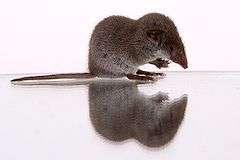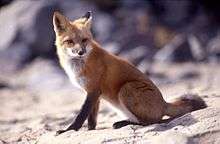List of mammals of Kyrgyzstan
This is a list of the mammal species recorded in Kyrgyzstan. There are 43 mammal species in Kyrgyzstan, of which 0 are critically endangered, 4 are endangered, 5 are vulnerable, and 3 are near-threatened.[1]
The following tags are used to highlight each species' conservation status as assessed by the IUCN:
| EX | Extinct | No reasonable doubt that the last individual has died. |
| EW | Extinct in the wild | Known only to survive in captivity or as a naturalized populations well outside its previous range. |
| CR | Critically Endangered | The species is in imminent risk of extinction in the wild. |
| EN | Endangered | The species is facing an extremely high risk of extinction in the wild. |
| VU | Vulnerable | The species is facing a high risk of extinction in the wild. |
| NT | Near Threatened | The species does not meet any of the criteria that would categorise it as risking extinction but it is likely to do so in the future. |
| LC | Least Concern | There are no current identifiable risks to the species. |
| DD | Data Deficient | There is inadequate information to make an assessment of the risks to this species. |
Some species were assessed using an earlier set of criteria. Species assessed using this system have the following instead of Near Threatened and Least Concern categories:
| LR/cd | Lower Risk/conservation dependent | Species which were the focus of conservation programmes and may have moved into a higher risk category if that programme was discontinued. |
| LR/nt | Lower Risk/near threatened | Species which are close to being classified as Vulnerable but are not the subject of conservation programmes. |
| LR/lc | Lower Risk/least concern | Species for which there are no identifiable risks. |
Subclass: Theria
Infraclass: Eutheria
Order: Rodentia (rodents)

Rodents make up the largest order of mammals, with over 40 percent of mammalian species. They have two incisors in the upper and lower jaw which grow continually and must be keep short by gnawing. Most rodents are small though the capybara can weigh up to 45 kg (100 lb).
- Suborder: Sciurognathi
- Family: Sciuridae (squirrels)
- Subfamily: Xerinae
- Tribe: Marmotini
- Genus: Marmota
- Gray marmot Marmota baibacina LR/lc
- Long-tailed marmot Marmota caudata LR/nt
- Menzbier's marmot Marmota menzbieri VU
- Genus: Spermophilus
- Tien Shan ground squirrel Spermophilus relictus LR/lc
- Genus: Marmota
- Tribe: Marmotini
- Subfamily: Xerinae
- Family: Gliridae (dormice)
- Subfamily: Leithiinae
- Genus: Dryomys
- Forest dormouse Dryomys nitedula LR/nt
- Genus: Dryomys
- Subfamily: Leithiinae
- Family: Dipodidae (jerboas)
- Subfamily: Allactaginae
- Genus: Allactaga
- Vinogradov's jerboa Allactaga vinogradovi LR/lc
- Genus: Allactaga
- Subfamily: Allactaginae
- Family: Cricetidae
- Subfamily: Arvicolinae
- Genus: Clethrionomys
- Tien Shan red-backed vole Clethrionomys centralis LR/lc
- Genus: Ellobius
- Alai mole vole Ellobius alaicus EN
- Genus: Microtus
- Tien Shan vole Microtus kirgisorum LR/lc
- Genus: Clethrionomys
- Subfamily: Arvicolinae
- Family: Muridae (mice, rats, voles, gerbils, hamsters, etc.)
- Subfamily: Gerbillinae
- Genus: Meriones
- Midday jird Meriones meridianus LR/lc
- Tamarisk jird Meriones tamariscinus LR/lc
- Genus: Meriones
- Subfamily: Murinae
- Genus: Rattus
- Turkestan rat Rattus turkestanicus LR/lc
- Genus: Rattus
- Subfamily: Gerbillinae
- Family: Sciuridae (squirrels)
Order: Lagomorpha (lagomorphs)
The lagomorphs comprise two families, Leporidae (hares and rabbits), and Ochotonidae (pikas). Though they can resemble rodents, and were classified as a superfamily in that order until the early 20th century, they have since been considered a separate order. They differ from rodents in a number of physical characteristics, such as having four incisors in the upper jaw rather than two.
- Family: Ochotonidae (pikas)
- Genus: Ochotona
- Large-eared pika Ochotona macrotis LR/lc
- Turkestan red pika Ochotona rutila LR/lc
- Genus: Ochotona
Order: Erinaceomorpha (hedgehogs and gymnures)
The order Erinaceomorpha contains a single family, Erinaceidae, which comprise the hedgehogs and gymnures. The hedgehogs are easily recognised by their spines while gymnures look more like large rats.
- Family: Erinaceidae (hedgehogs)
- Subfamily: Erinaceinae
- Genus: Hemiechinus
- Long-eared hedgehog Hemiechinus auritus LR/lc
- Genus: Hemiechinus
- Subfamily: Erinaceinae
Order: Soricomorpha (shrews, moles, and solenodons)
The "shrew-forms" are insectivorous mammals. The shrews and solenodons closely resemble mice while the moles are stout-bodied burrowers.
- Family: Soricidae (shrews)
- Subfamily: Crocidurinae
- Genus: Crocidura
- Gueldenstaedt's shrew Crocidura gueldenstaedtii LR/lc
- Lesser white-toothed shrew Crocidura suaveolens LR/lc
- Genus: Crocidura
- Subfamily: Soricinae
- Tribe: Nectogalini
- Genus: Neomys
- Eurasian water shrew Neomys fodiens LR/lc
- Genus: Neomys
- Tribe: Soricini
- Genus: Sorex
- Eurasian pygmy shrew Sorex minutus LR/lc
- Genus: Sorex
- Tribe: Nectogalini
- Subfamily: Crocidurinae
Order: Chiroptera (bats)
The bats' most distinguishing feature is that their forelimbs are developed as wings, making them the only mammals in the world naturally capable of flight. Bat species account for about 20% of all mammals.
- Family: Vespertilionidae
- Subfamily: Myotinae
- Genus: Myotis
- Geoffroy's bat Myotis emarginatus VU
- Genus: Myotis
- Subfamily: Vespertilioninae
- Genus: Eptesicus
- Botta's serotine Eptesicus bottae LC
- Genus: Eptesicus
- Subfamily: Myotinae
- Family: Rhinolophidae
- Subfamily: Rhinolophinae
- Genus: Rhinolophus
- Greater horseshoe bat Rhinolophus ferrumequinum LR/nt
- Lesser horseshoe bat Rhinolophus hipposideros LC
- Genus: Rhinolophus
- Subfamily: Rhinolophinae
Order: Carnivora (carnivorans)
There are over 260 species of carnivorans, the majority of which feed primarily on meat. They have a characteristic skull shape and dentition.
- Suborder: Feliformia
- Family: Felidae (cats)
- Subfamily: Felinae
- Genus: Acinonyx
- Asiatic cheetah Acinonyx jubatus venaticus CR
- Genus: Felis
- Jungle cat Felis chaus LC
- Turkestan wildcat Felis silvestris caudata LC
- Pallas's cat Felis manul NT
- Genus: Lynx
- Eurasian lynx Lynx lynx NT
- Genus: Acinonyx
- Subfamily: Pantherinae
- Genus: Panthera
- Caspian tiger Panthera tigris virgata EN
- Genus: Uncia
- Snow leopard Uncia uncia EN
- Genus: Panthera
- Subfamily: Felinae
- Family: Felidae (cats)
- Suborder: Caniformia
- Family: Canidae (dogs, foxes)
- Genus: Vulpes
- Corsac fox Vulpes corsac LC
- Red fox Vulpes vulpes LC
- Genus: Canis
- Gray wolf Canis lupus LC
- Genus: Cuon
- Tien Shan dhole Cuon alpinus hesperius EN/cr
- Genus: Vulpes
- Family: Ursidae (bears)
- Genus: Ursus
- Brown bear Ursus arctos LR/lc
- Genus: Ursus
- Family: Mustelidae (mustelids)
- Genus: Mustela
- Stoat Mustela erminea LR/lc
- Steppe polecat Mustela eversmannii LR/lc
- Least weasel Mustela nivalis LR/lc
- Genus: Martes
- Beech marten Martes foina LR/lc
- Genus: Lutra
- European otter Lutra lutra NT
- Genus: Mustela
- Family: Canidae (dogs, foxes)
Order: Artiodactyla (even-toed ungulates)
The even-toed ungulates are ungulates whose weight is borne about equally by the third and fourth toes, rather than mostly or entirely by the third as in perissodactyls. There are about 220 artiodactyl species, including many that are of great economic importance to humans.

- Family: Bovidae (cattle, antelope, sheep, goats)
- Subfamily: Antilopinae
- Genus: Gazella
- Goitered gazelle Gazella subgutturosa VU
- Genus: Gazella
- Subfamily: Caprinae
- Genus: Capra
- Siberian ibex Capra sibrica LR/lc
- Genus: Ovis
- Argali Ovis ammon VU
- Genus: Capra
- Subfamily: Antilopinae
- Family: Cervidae (deer)
- Subfamily: Cervinae
- Subfamily: Odocoileinae
- Genus: Capreolus
- Siberian roe deer Capreolus pygargus
- Genus: Capreolus
Notes
- ↑ This list is derived from the IUCN Red List which lists species of mammals and includes those mammals that have recently been classified as extinct (since 1500 AD). The taxonomy and naming of the individual species is based on those used in existing Wikipedia articles as of 21 May 2007 and supplemented by the common names and taxonomy from the IUCN, Smithsonian Institution, or University of Michigan where no Wikipedia article was available.
References
- "The IUCN Red List of Threatened Species: Mammals of Kyrgyzstan". IUCN. 2001. Retrieved 22 May 2007.
- "Mammal Species of the World". Smithsonian National Museum of Natural History. 2005. Archived from the original on 27 April 2007. Retrieved 22 May 2007.
- "Animal Diversity Web". University of Michigan Museum of Zoology. 1995–2006. Retrieved 22 May 2007.
See also
- List of chordate orders
- List of regional mammals lists
- List of prehistoric mammals
- Mammal classification
- New mammal species





.jpg)